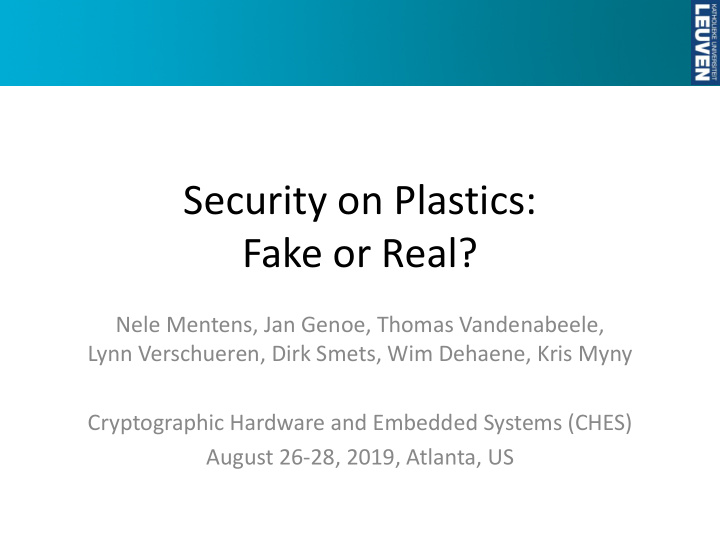



Security on Plastics: Fake or Real? Nele Mentens, Jan Genoe, Thomas Vandenabeele, Lynn Verschueren, Dirk Smets, Wim Dehaene, Kris Myny Cryptographic Hardware and Embedded Systems (CHES) August 26-28, 2019, Atlanta, US
Outline • Flexible electronics on plastics • Our implementation • Our key hiding solution • Conclusion CHES, 2019, Atlanta, US
Flexible electronics on plastics Applications • Commercially used in flexible displays • Large potential for flexible digital circuits in (passive) RFID/NFC chips, integrated in paper or plastics • Examples: smart packages, intelligent labels, electronic paper [source figures: imec] CHES, 2019, Atlanta, US
Flexible electronics on plastics Technology • Several thin-film transistor (TFT) technologies exist • Amorphous metal-oxide TFTs show the best combination of high performance and low processing cost • Materials: – Mo = molybdenum – SiO 2 = silicon dioxide – SiN = silicon nitride – a-IGZO = amorphous indium gallium zinc oxide CHES, 2019, Atlanta, US
Flexible electronics on plastics Comparison with silicon transistors silicon (10 nm) a-IGZO (5 µm) Core supply 0.7 V 5-10 V Higher power consumption voltage Charge carrier 500-1500 cm 2 /Vs 2-20 cm 2 /Vs Lower performance mobility Transistor 10 3 -10 4 per cm 2 Larger area ~ 45 mio per mm 2 density Semiconductor Unipolar logic n-type and p-type only n-type type Cost per 1000 Lower cost > 0.3 USD > 0.01 USD transistors Flexible? no yes Bendable, stretchable CHES, 2019, Atlanta, US
Flexible electronics on plastics Security challenge • To secure the communication between the flexible tag and the reader, many hurdles need to be overcome • In this work, we concentrate on two challenges: – Integrate crypto cores in the flexible chip • The maximum number of TFTs in one chip, reported up to now, is only 3504 – Prevent the key bits from being read out • The chips are not packaged and the features are relatively large [source figures: imec] • There is no electrically readable/writable memory CHES, 2019, Atlanta, US
Our implementation Design choices algorithm architecture gate transistor CHES, 2019, Atlanta, US
Our implementation Design choices KTANTAN32* • Block size: 32 bits algorithm • Key size: 80 bits • Fixed key architecture gate transistor *C. De Cannière, O. Dunkelman, M. Knežević , KATAN and KTANTAN — a family of small and efficient hardware-oriented block ciphers , CHES 2009, p. 272-288. CHES, 2019, Atlanta, US
Our implementation Design choices Serial architecture • Inputs: start, clk, pt algorithm • Outputs: ready, ct architecture gate transistor CHES, 2019, Atlanta, US
Our implementation Design choices pseudo-CMOS logic • 6 TFTs in one NAND gate algorithm • Pull-Down Network (PDN) repeated V bias > V DD + 2V T rail-to-rail output • architecture gate transistor CHES, 2019, Atlanta, US
Our implementation Design choices algorithm a-IGZO semiconductor architecture gate transistor CHES, 2019, Atlanta, US
Our implementation Layout • 4044 TFTs • 331.5 mm 2 48 pads for I/O, V DD , V bias and GND CHES, 2019, Atlanta, US
Our implementation Measurement setup level shifters FPGA chip probe card
Our implementation Measurement results • Fixed 80-bit key: 07C1F07C1F07C1F07C1F (hex) • 1000 plaintexts automatically applied • 1000 correct ciphertexts for: – V DD = 10 V and V bias = 15 V – V DD = 11 V and V bias = 16.5 V • Maximum clock frequency = 10 kHz • Number of cycles: – 32 (for shifting in the plaintext) – 254 (for the actual encryption) – 32 (for shifting out the ciphertext) • Total latency = 31.8 ms CHES, 2019, Atlanta, US
Our implementation Key programming CHES, 2019, Atlanta, US
Our implementation Key programming CHES, 2019, Atlanta, US
Our implementation Key programming PROBLEM: The key bits can easily be read out using a microscope CHES, 2019, Atlanta, US
Our key hiding solution Proposed concept First option for key programming The temperature change caused by lasering, shifts the threshold voltage ( V T ) and thus the I d - V g graph With a fixed input voltage ( V neg ), the Second option for key programming TFT switches from off to on CHES, 2019, Atlanta, US
Our key hiding solution Experimental validation TFT microscope images PROBLEM: The difference is visible between a TFT that has been lasered and a TFT that has not been lasered lasered not lasered CHES, 2019, Atlanta, US
Our key hiding solution Experimental validation SOLUTION: Apply different settings of the laser to cause different V T shifts that cannot be visually distinguished: • Setting 1 (top image): attenuation of 45 dB in low energy mode; one pulse applied • Setting 2 (bottom image): attenuation of 35 dB in low energy mode; two pulses applied CHES, 2019, Atlanta, US
Conclusion • We presented: – The first cryptographic core on flex foil – A solution for the “ invisible ” programming of the key bits • There are many more security challenges to be tackled • The technology is rapidly improving and soon ready for mainstream applications • It is crucial to guarantee the security of these applications CHES, 2019, Atlanta, US
Recommend
More recommend